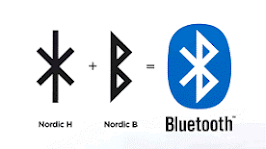INTERNET / WORLD WIDE WEB / WI-FI / BLUETOOTH
A global network of computer networks known as the Internet links computers from all over the world. People can share information and converse via the Internet from any location with an Internet connection. Regarding the development of the Internet, notable figures like Tim Berners-Lee, Paul Baran, Lawrence Roberts, Vinton Cerf, Robert Kahn, and others are mentioned. Vinton Cerf and Kahn, on the other hand, were the two individuals responsible for creating the TCP/ICP (the collection of protocols that regulates how data passes through a network) protocols and the internet architecture.
On January 1, 1983, the Internet was initially developed for military use before being broadened to allow scientific collaboration. The demand for computers also increased in the 1960s, which helped create the Internet. In the past, government researchers used the Internet to exchange information. With ASCII-based end-user tools like Gopher, which allowed you to use a menu to search through structured collections of files, it was a world that was almost exclusively built on text. Nowadays, the Internet offers virtually infinite services, including the ability to transmit money internationally, collaborate globally, learn from others, form international social connections, exchange news, and many more. The World Wide Web, sometimes abbreviated as the Web or WWW, refers to all the open websites or pages people can visit on their personal computers and other internet-connected devices. Tim Berners-Lee, a British scientist, was the original creator of The World Wide Web, which he invented in 1989. It was first developed and used to address the demand for automatic information-sharing amongst scientists in universities and institutes worldwide. These days, there are various ways to use the Internet, including for communication, online meetings or conferences, watching entertaining videos, doing Internet research, and many other things.
Despite what some people may believe, the World Wide Web and the Internet are not interchangeable. The Internet, which is the network of computers on which the web runs and over which emails and files are transmitted, is a collection of billions of websites that may be visited. Tim Berners-Lee and others unveiled the first website on August 6, 1991. People could learn about hypertext (coded words or phrases that link to content) and how to make web pages from it. Today, the original website is still operational and accessible at https://info.cern.ch/hypertext/WWW/TheProject.html.
The Austrian-American actress and inventor Hedy Lamarr invented the technology that would later serve as the foundation for today's Wi-Fi, GPS, and Bluetooth communication systems. She would spend many hours testing theories and experimenting with technologies in her trailer on set. She created "frequency hopping," a technique for jumping between radio bands to prevent signal jamming. The innovation created a robust code that could prevent secret messages from being intercepted by adjusting radio frequencies at irregular intervals between transmission and reception. However, Hedy Lamarr contributed to developing "spread spectrum" technology, which would become the cornerstone of contemporary wireless communication technology and support the rise of smartphones and Wi-Fi connections. Hedy Lamarr is one of the people with the most remarkable lives ever, and there is a song by Jeff Beck and Johnny Depp devoted to her. Her radio communication system, which she developed as a Hollywood celebrity and for a time was regarded as the most beautiful woman in the world, served as the inspiration for the development of Wi-Fi. In the song's more profound significance, Hedy Lamarr's life represents how someone can lose their fight to be recognized for their brilliance if the world perceives them differently. Her trap was her attractiveness, which kept her from showing her intelligence.
- https://www.britannica.com/technology/Interne
- https://www.usg.edu/galileo/skills/unit07/internet07_02.phtml#:~:text=In%20response%20to%20this%2C%20other,to%20communicate%20with%20each%20other.
- https://www.sciencefocus.com/science/who-really-invented-the-internet
- https://sites.cs.ucsb.edu/~almeroth/classes/F04.176A/homework1_good_papers/Alaa-Gharbawi.html#:~:text=The%20computer%20networking%20revolution%20began,for%20computers%20in%20the%201960s.
- https://www.usg.edu/galileo/skills/unit07/internet07_02.phtml#:~:text=Sharing%20Resources,government%20researchers%20to%20share%20information.
- https://www.zdnet.com/article/before-the-web-the-internet-in-1991/
- https://www.techtarget.com/whatis/definition/World-Wide-Web#:~:text=The%20World%20Wide%20Web%20%2D%2D,users%20click%20on%20for%20information.
- https://home.cern/science/computing/birth-web/short-history-web#:~:text=Where%20the%20Web%20was%20born,and%20institutes%20around%20the%20world.
- https://www.vpnblade.com/10-uses-of-world-wide-web-and-importance/
- https://quizlet.com/272824469/cisb-11-flash-cards/
- https://www.bbc.co.uk/newsround/av/47523993
- https://www.npr.org/2021/08/06/1025554426/a-look-back-at-the-very-first-website-ever-launched-30-years-later#:~:text=On%20August%206%2C%201991%2C%20the,about%20how%20to%20use%20it.
- https://thehackernews.com/2016/08/first-website-ever.html#:~:text=The%20world's%20first%20website%2C%20which,%2FWWW%2FTheProject.html.
- https://www.womenshistory.org/education-resources/biographies/hedy-lamarr
- https://auralcrave.com/en/2022/06/09/johnny-depp-the-song-for-hedy-lamarr-the-lyrics-meaning/
- https://www.invent.org/inductees/jaap-c-haartsen#:~:text=Jaap%20Haartsen%20has%20been%20active,seemingly%20endless%20array%20of%20devices.
- https://www.lexology.com/library/detail.aspx?g=133dbd48-902c-443c-8c0a-2951fca18389
- https://beambox.com/townsquare/the-history-of-wifi-a-brief-introduction
- https://www.britannica.com/technology/Wi-Fi







Comments
Post a Comment